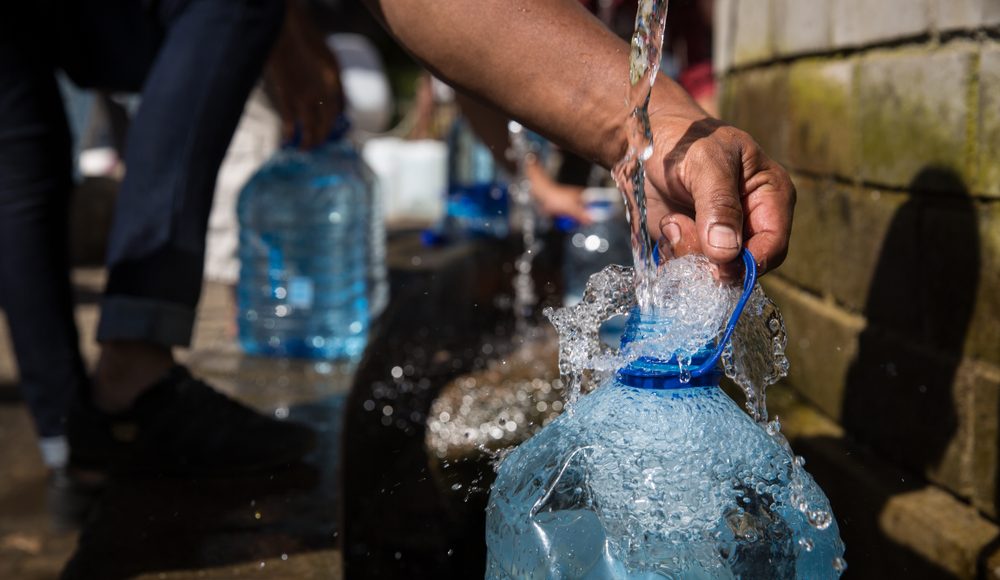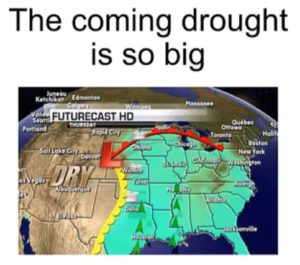It is critical to have a regular water intake during a heatwave, and you must figure out ways to preserve your body’s water.
I have practiced outdoor survival skills in arid Arizona quite a few times, and I took advantage of the experience and training of my survival instructor. One thing that stuck with me the first time we prepared our trip was that before we set off down the trail, he made me open my canteen, and he poured a teaspoon of apple cider vinegar in it.
Seeing my shocked face, he began explaining that vinegar is a helpful substance to those struggling to function in a hot and dry environment. He told me that vinegar stimulates the hypothalamus, the gland responsible for our body’s cooling system. Adding one teaspoon of apple cider vinegar to a quart of water can help you tolerate the heat without feeling stressed and drained.
Another benefit of vinegar, as he stated, is that mosquitoes will bite you less if you consume vinegar regularly and if it’s part of your daily diet.
He advised me to take only what I need and to travel as light as possible. This good practice has stayed with me, and I try to make my survival bags as light as possible and include only items with multiple uses.
Pick your clothes properly
When you cross an arid environment, you have to think of what you should wear and understand that the desert is no place for fashion. You can stop to rest under trees or in the shade of the north side of hills because the temperature in shaded areas is usually 20 degrees cooler. Even so, you have to pick your clothing items correctly.
The desert is no place for skimpy shorts and tiny tank tops. Go with long pants, long-sleeved shirts, and always wear a hat (preferably a wide-brimmed hat). Your clothes should be light and airy, and make sure you pick something light-colored.
It is essential to cover your skin not only because you will protect it from sunburns but also from brushing up against vegetation when walking through the narrow portions of the trail. The last thing you want is to brush up against poison oak.
Think about how desert nomads dress. They don’t have the luxury to go home to air conditioning or use lotions to soothe sunburns. They’ve learned a while back they need to cover themselves up to avoid suffering from heat strokes and dying. They wear loose-fitting robes, and they always keep their heads covered.
And when you pick your clothes, make sure you choose the ones made of cotton and natural fibers because polyesters do not allow good air circulation.
A word on evaporative cooling
One trick I learned during my desert trips was to wet my clothes whenever I would find a water source and fill my canteen (after I had my full) if the water was potable.
Why should I wet my clothes?
Well, this is a tactic that the ancient Egyptians once used. They would use the evaporative cooling method to cool their homes. They would hang wet rugs in the windows and door openings so that the wind blowing through their homes would evaporate the water rapped in the rugs and cool the air in their homes. Your wet clothes will similarly cool you if you employ this tactic.
The needed water
I mentioned the need to have a proper water intake when venturing out into the desert and carry your water with you. Even more, you must find ways to preserve your body’s water.
This Device Easily Turns Air Into Water!
For example, any physical activity you plan on doing should be done at night. If you travel with a companion and are short on water, try to keep talking to a minimum. If you get trapped or stranded, don’t yell and figure out other ways to signal for help. And if you’re a smoker, try to leave your cigarettes in the car.
All these scenarios will cause a significant water loss, so keep them in mind the next time you decide to hike in the desert.
If there aren’t any obvious water sources around, you can try and get your water from cacti, and I’ve eaten cactus on several occasions just for this reason alone. You can find edible cactus through most of this country and the prickly pear, with its 90 percent water content, is the most common one. Pick a young cactus pad, and you will be able to scrape its spines easily. Peel the skin using your knife and eat the green cactus. Always go for the younger pads since they are much tender and taste like a sour green pepper.
There are other edible wild plants in the desert, but you have to be sure you identified them correctly before you decide to eat them or tap them for water.
To figure out if you’re dehydrated, you can check your urine. The darker the color of the urine, the less hydrated you are.
How about those salt tablets for your water canteen?
A while back, people were encouraged to add salt tablets to their drinking water during heatwaves. This is still a common practice today, and it’s one of those survival myths that it’s hard to defeat. It was believed that your body loses sodium by sweating, and it needs to be replaced.
However, it was discovered that you do not lose that much sodium in sweat, and your body loses more water than salt during the perspiration process. After profuse sweating, it was discovered that people had a high percentage of salt in their blood. So, you can imagine that adding salt tablets to your drinking water may not be healthy at all unless. Salt tablets should only be used in case someone suffers from painful heat cramps.
It’s all about common sense
If you plan a camping or hiking trip in an arid environment, use common sense. To stay cool and healthy when the heat becomes unbearable, remember to drink a lot of water, pace yourself and stay in the shade as much as possible, come out at night and keep talking and other activities to a minimum.
Avoid drinking a cold one or two or any alcohol during extreme heat because alcohol acts as a diuretic. Eventually, you will end up urinating out and sweating more water than you drink. The same goes for coffee. Even though it’s not as bad as alcohol, it still acts as a diuretic, especially if you ingest it within a short period. If you do want to indulge yourself with a coffee, drink it slowly throughout the day.
Also, consider that specific heat-related health issues may occur, such as heat cramps, heat exhaustion, and heatstroke. Heat-related illnesses are preventable, and they only happen when your body becomes unable to cool itself and overheats. They can affect anyone, and the more direct sun, heat, and humidity your experience, the more you are at risk.
Heat cramps
Your body losses electrolytes through sweat, and these electrolytes are needed for your body to function. If you have symptoms such as heat rash and itching, hot and moist skin, and painful cramps in your arms, legs, or abdomen, then you might suffer from heat cramps.
In general, heat cramps occur in people that sweat profusely and drink large quantities of water but fail to replace the body’s salt loss. In such cases, it is recommended administrating salt tablets with every two glasses of water, and the patient should be moved to a cool and well-ventilated area.
Heath exhaustion and heat stroke
These are the most severe heat-related illnesses someone can experience in an arid environment.
Heat exhaustion occurs when the circulatory system fails to give off excessive heat, and it’s defined as a mild form of shock. If you have symptoms such as headaches, weakness, dizziness, sudden mood changes, irritability or confusion, stomachache, and pale, clammy skin, you might suffer from heat exhaustion.
The patient with heat exhaustion should be moved to a cool, shaded place and monitored closely. Remove any heavy clothing and lay the person on their back, making sure you raise their legs at about 8 inches from the ground. If the patient complains of stomach problems, lay them on their side in case of vomiting. This will prevent the patient from drowning in their vomit. Try to cool the patient using a wet cloth on their skin or pour water if available. Also, fanning them with any improvised means dramatically helps.
Heatstroke is the more serious of all heat-related health issues, and it has similar symptoms to heat exhaustion. However, a patient experiencing a heat stroke will show convulsions, seizures, loss of consciousness, high temperature – 104 degrees or higher, and no detectable pulse.
Heatstroke is a life-threatening condition, and the patient needs immediate treatment. You must lower the person’s temperature as rapidly as possible, and the best way to do so is by using ice packs in the armpits and groin, of course, if available. The body temperature must be lowered to 102 degrees, and from there, you must keep the patient cool and monitor their temperature every 10 minutes for a possible febrile rebound.
Concluding
Any arid environment can prove to be demanding to put it lightly. It’s not a hostile environment as some are used to calling it, and, in my opinion, it’s neutral and impassive.
It’s up to you to never underestimate the serious and dangerous nature of the desert and how it can create many problems for your wellbeing if you try to conquer it unprepared.











Tom MacGyver | August 13, 2021
|
If you’re going to put vinegar in a canteen, be sure it’s not a metal one. Putting anything acidic in the water will cause etching of the metal. Your water will taste like the metal.
I don’t put salt in my drinking water. That being said, anyone who lives in the desert knows you lose a good chunk of salt through perspiration. I do my workouts in desert heat and when I’m done my shirt will be WHITE with salt. If I’m doing an all-dayer, I alternately drink water and diluted Gatorade. when it’s as hot as it is, undiluted Gatorade will taste like pancake syrup!
I live in the Wild, Wild West. Every year people die literally in sight of civilization because they decide to go hiking in shorts and tee shirts, carrying a bottle of water in their day packs. Folks, there’s a BIG difference between “hot” an arid. Go hiking in southern Florida, and you’ll be sweating like a horse in minutes. You realize right away that you’re losing a lot of water. This is because high humidity impairs evaporation. In an arid climate the humidity is VERY low; sometimes in the single digits. It doesn’t feel as hot as it really is. This means your sweat will evaporate immediately. You won’t even know it’s happening. Furthermore, this evaporation means your body will cool efficiently, so you won’t feel as hot as you really are. A few miles in, you’ve exhausted your water. Your body sweats what it has off, and now you’re in trouble. You start to overheat. You become disoriented. You become delirious. You die… a couple of hundred feet from where you parked the car… The mountain near where I live looks tame, and yet it takes eight or nine lives per year because people don’t know what they’re doing.
If you’re new to the desert, PLEASE take the advice of the locals! They live with the dry heat for most of the year. They know how to deal with it. The wise among them will tell you that sometimes the best thing to do is to stay inside! Even if desert heat is old hat to you, TELL SOMEONE WHERE YOU’RE GOING BEFORE YOU SET OUT!
Paul | August 14, 2021
|
I live off grid in the middle of the Mojave Desert. When it gets over 100 which is mostly all summer, I go outside. in the morning to get work done. If you interested in desert living come visit me me through hip camp.